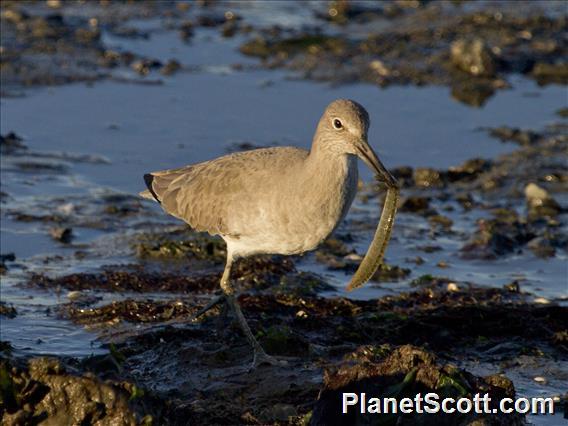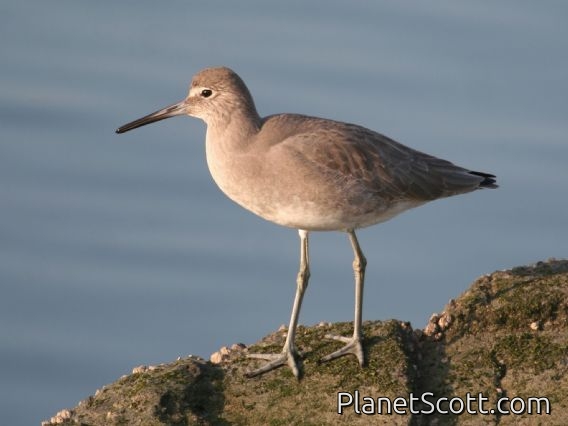Willet (Tringa semipalmata)

Willet (Tringa semipalmata)

Willet (Catoptrophorus semipalmatus)


×



Willet (Tringa semipalmata)

Willet (Catoptrophorus semipalmatus)
About Willet (Tringa semipalmata)
- Kingdom: Animals
- Phylum: Chordates
- Class: Birds
- Order: Pelicans
- Family: Sandpipers and Allies
The willet is a large shorebird in the family Scolopacidae. It is a relatively large and robust sandpiper and is the largest of the species called "shanks" in the genus Tringa. Its closest relative is the lesser yellowlegs, a much smaller bird with a very different appearance apart from the fine, clear, and dense pattern of the neck, which both species show in breeding plumage. It breeds in North America and the West Indies and winters in southern North America, Central America, the West Indies and South America.
Source: Wikipedia
Trips
Visits
-
2006-09-24
Elkhorn Slough, United States of America -
2007-01-01
Candlestick Park, United States of America -
2007-01-25
Heron's Head Park, United States of America -
2007-04-10
Ejido Lagoon, United States of America -
2007-06-14
Cape May National Wildlife Refuge - Deleware Bay, United States of America -
2007-10-10
La Mancha, Mexico -
2008-01-05
Yelapa, Mexico -
2008-01-26
Heron's Head Park, United States of America -
2008-02-21
Puerto Adolfo Lopes Mateos, Mexico -
2009-01-22
Cay Caulker, Belize -
2009-02-24
Puerto Jiminez, Costa Rica -
2009-03-19
Punta Patino, Panama -
2009-10-01
Crissy Field, United States of America -
2009-11-22
Palo Alto Baylands, United States of America -
2009-11-29
Heron's Head Park, United States of America -
2009-12-31
Palo Alto Baylands, United States of America -
2010-01-01
Arrowhead Marsh, United States of America -
2012-04-14
Heron's Head Park, United States of America -
2012-07-10
Chase Lake NWR, United States of America -
2012-08-12
Foster City Beach, United States of America -
2012-08-12
Coyote Point County Park--harbor and marsh, United States of America -
2012-09-19
Sutro Heights--Baths / Land's End, United States of America -
2012-09-19
Sutro Heights--Baths / Land's End, United States of America -
2012-09-23
Heron's Head Park, United States of America -
2012-12-13
Heron's Head Park, United States of America -
2013-03-23
Coyote Point County Park--harbor and marsh, United States of America -
2013-03-30
Heron's Head Park, United States of America -
2013-04-16
Aransas NWR (CTC 037) (Aransas Co.), United States of America -
2013-04-17
Brazoria NWR (UTC 108), United States of America -
2013-04-18
Galveston Island, United States of America -
2013-08-05
Heron's Head Park, United States of America -
2013-12-01
Heron's Head Park, United States of America -
2014-01-01
Heron's Head Park, United States of America -
2014-01-11
Heron's Head Park, United States of America -
2014-01-14
Candlestick Park, United States of America -
2014-03-11
Elkhorn Slough, United States of America -
2014-05-26
Heron's Head Park, United States of America -
2014-11-01
Yosemite Slough, United States of America -
2014-12-21
Arrowhead Marsh, United States of America -
2014-12-27
Heron's Head Park, United States of America -
2015-01-01
Candlestick Park, United States of America -
2015-01-10
Half Moon Bay - Pillar Point, United States of America -
2015-01-20
Arrowhead Marsh, United States of America -
-
-
-
-
-
-
-
-
-
-
-
-
-
-
-
-
-
-
-
-
-
-
-
-
-
-
-
-
-
-
-




